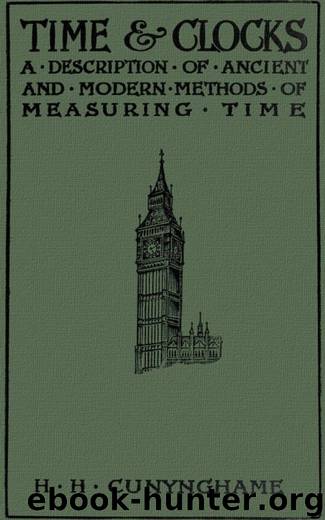Time and Clocks - A Description of Ancient and Modern Methods of Measuring Time by Sir Henry H. Cunynghame

Author:Sir Henry H. Cunynghame [Cunynghame, Sir Henry H. (Henry Hardinge)]
Language: eng
Format: epub
Publisher: anboco
Published: 2017-04-12T22:00:00+00:00
Fig. 34.
Fig. 35.
Next we will knock a tintack into any point B, and tie a string on to B. Then if I pull at the string in any direction B C the board tends to twist round the screw at A. What will the strength of the twisting force be? It will depend on the strength of the pull, and on the “leverage,” or distance of the line C B from A. We might imagine the string, instead of being attached at B, to be attached at D; then, if I put P as the strength of the pull, the twisting power would be represented by P × A D. This is called the “moment” of the force P round the centre A. It would be the same as if I had simply an arm A D, and pulled upon it with the force P. It is an experimental truth, known to the old Greek philosophers, that moments, or twisting powers, are equal when in each case the result of multiplying the arm by the power acting at right angles to it is equal.
Now suppose A B is a pendulum, with a bob B of 10 lbs. weight, and suppose it has been drawn aside out of the vertical so that the bob is in the position B. Then the weight of the bob will act vertically downwards along the line B C. The moment, or twisting power, of the weight will be equal to 10 lbs. multiplied by A D, A D being a line perpendicular to B C.
Download
This site does not store any files on its server. We only index and link to content provided by other sites. Please contact the content providers to delete copyright contents if any and email us, we'll remove relevant links or contents immediately.
| Automotive | Engineering |
| Transportation |
Whiskies Galore by Ian Buxton(41879)
Introduction to Aircraft Design (Cambridge Aerospace Series) by John P. Fielding(33064)
Small Unmanned Fixed-wing Aircraft Design by Andrew J. Keane Andras Sobester James P. Scanlan & András Sóbester & James P. Scanlan(32743)
Craft Beer for the Homebrewer by Michael Agnew(18140)
Turbulence by E. J. Noyes(7936)
The Complete Stick Figure Physics Tutorials by Allen Sarah(7307)
Kaplan MCAT General Chemistry Review by Kaplan(6867)
The Thirst by Nesbo Jo(6828)
Bad Blood by John Carreyrou(6552)
Modelling of Convective Heat and Mass Transfer in Rotating Flows by Igor V. Shevchuk(6391)
Learning SQL by Alan Beaulieu(6211)
Weapons of Math Destruction by Cathy O'Neil(6146)
Man-made Catastrophes and Risk Information Concealment by Dmitry Chernov & Didier Sornette(5921)
Digital Minimalism by Cal Newport;(5664)
Life 3.0: Being Human in the Age of Artificial Intelligence by Tegmark Max(5474)
iGen by Jean M. Twenge(5366)
Secrets of Antigravity Propulsion: Tesla, UFOs, and Classified Aerospace Technology by Ph.D. Paul A. Laviolette(5309)
Design of Trajectory Optimization Approach for Space Maneuver Vehicle Skip Entry Problems by Runqi Chai & Al Savvaris & Antonios Tsourdos & Senchun Chai(5011)
Pale Blue Dot by Carl Sagan(4912)
